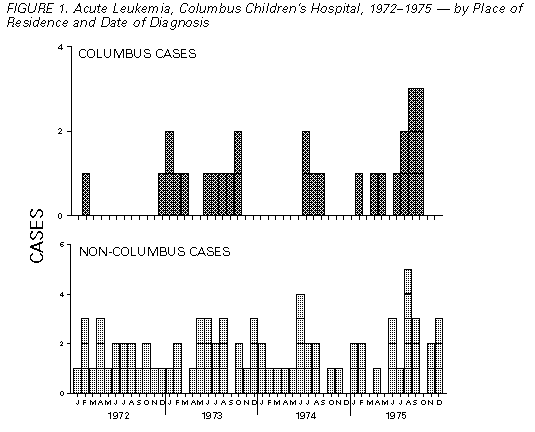 |
|
|
|
|
|
|
| ||||||||||
|
|
|
|
|
|
|
||||
| ||||||||||
|
|
|
|
|
Persons using assistive technology might not be able to fully access information in this file. For assistance, please send e-mail to: mmwrq@cdc.gov. Type 508 Accommodation and the title of the report in the subject line of e-mail. Epidemiologic Notes and Reports Acute Childhood Leukemia -- Columbus, OhioAs part of its commemoration of CDC's 50th anniversary, MMWR is reprinting selected MMWR articles of historical importance to public health, accompanied by current editorial notes. Reprinted below are two reports, published March 19, 1976, and June 11, 1976, respectively, concerning childhood cancer in Columbus, Ohio (acute childhood leukemia), and Winchester, Virginia (Burkitt's lymphoma). They illustrate the problem of cancer case clusters in communities and the public health approaches used in response. From August-October 1975, 8 cases of acute leukemia were diagnosed at Columbus Children's Hospital in Columbus, Ohio, in children living in that city. During any consecutive 3-month period in 1972-1974, the greatest number of cases of acute leukemia diagnosed at this hospital in Columbus children was 4 (Figure_1). To evaluate this cluster of illness, all cases of acute leukemia diagnosed at Columbus Children's Hospital in 1972-1975 were reviewed with respect to age, race, sex, type of leukemia, date of diagnosis, and residence in and outside of Columbus (Table_1). The hospital provides care for most children with leukemia in Columbus and for many such patients from surrounding areas. In the 3-year period 1972-1974, an average of 5.3 cases of acute childhood leukemia were seen each year among Columbus residents (the expected number is 6.1, based on age-specific rates from the Third National Cancer Survey {1}). Over the 4-year period 1972-1975, 107 cases were seen, 28 among Columbus residents. Both Columbus and non-Columbus patients in 1975 were somewhat older and included relatively more females than in earlier years. Case distributions by race and leukemia cell type were not unusual. Twelve cases were diagnosed in Columbus residents in 1975, compared with a total of 16 for all 3 preceding years. To assess the possibility of time-space clustering among Columbus cases over the entire 4-year period a statistical analysis was performed using the procedure devised by Knox (2). No statistically significant clustering was found; 13 case-pairs were observed in which dates of diagnosis were less than 1 year apart and places of residence 1 mile or less apart, whereas 14.4 pairs were to be expected on a random basis. Inspection of the 1975 case data showed no geographic clustering and no obvious community or family interrelationships among cases. No evidence of seasonal periodicity was found on statistical testing by month of diagnosis for pooled data from all 4 years. Reported by: I Ertel, MD, W Newton, MD, Children's Hospital, Columbus, Ohio; TJ Halpin, MD, MPH, State Epidemiologist, Ohio Department of Health; Field Services Div and Cancer and Birth Defects Div, Bur of Epidemiology, CDC. Editorial NoteEditorial Note: The question of time-space clustering among cases of leukemia and lymphoma has received considerable epidemiologic attention, particularly in connection with hypotheses regarding the possible viral etiology of cancer. While no evidence has been found of statistically significant time-space clustering among adult cases, several studies have suggested such a tendency among cases of childhood acute leukemia (2-5). The significance of such observations remains unclear. In the present investigation no evidence, statistical or otherwise, was found to suggest that the recent case cluster in Columbus might be due to factors other than chance. Further investigations of such clusters may be desirable, however, as a potential source of clues regarding the etiology of childhood tumors. References
Figure_1  Return to top. Table_1 Note: To print large tables and graphs users may have to change their printer settings to landscape and use a small font size.
TABLE 1. Acute Leukemia, Columbus Children's Hospital, 1972-1975 -- By Age, Sex,
Race, Place of Residence, and Year of Diagnosis
==================================================================================
Year of Diagnosis
-------------------------------------------
1972-1974 1975
-------------------------------------------
Columbus Columbus
Residents Other Residents Other
------------------------------------------------------------------------
Total number of cases 16 57 12 22
Mean age at diagnosis 4.5 5.4 7.0 6.5
Sex: Male 10 33 5 11
Female 6 19 7 11
Race: White 13 55 9 21
Black 3 2 0 1
Other 0 0 1 0
Unknown 0 0 2 0
Leukemic Cell Type:
Myelocytic 3 11 3 4
Monocytic 2 2 0 0
Lymphocytic or Stem Cell 11 44 9 18
------------------------------------------------------------------------
==================================================================================
Return to top. Disclaimer All MMWR HTML versions of articles are electronic conversions from ASCII text into HTML. This conversion may have resulted in character translation or format errors in the HTML version. Users should not rely on this HTML document, but are referred to the electronic PDF version and/or the original MMWR paper copy for the official text, figures, and tables. An original paper copy of this issue can be obtained from the Superintendent of Documents, U.S. Government Printing Office (GPO), Washington, DC 20402-9371; telephone: (202) 512-1800. Contact GPO for current prices. **Questions or messages regarding errors in formatting should be addressed to mmwrq@cdc.gov.Page converted: 09/19/98 |
|||||||||
This page last reviewed 5/2/01
|